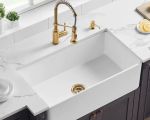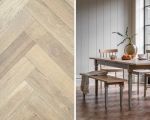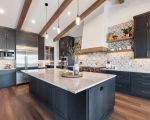- 1-Understanding-Kitchen-Flooring-Needs
- 2-Evaluating-Durability-and-Maintenance
- 3-Considering-Aesthetic-Appeal-and-Style
- 4-Assessing-Budget-and-Long-Term-Costs
- 5-Exploring-Popular-Kitchen-Flooring-Materials
- 6-Real-Life-Examples-of-Flooring-Choices
1. Understanding Kitchen Flooring Needs
Choosing the right flooring for your kitchen starts with understanding the unique demands of this space. Kitchens are high-traffic areas exposed to spills, moisture, and frequent cleaning. Therefore, kitchen flooring must combine durability, water resistance, and comfort to support daily activities. Recognizing these needs helps homeowners avoid costly mistakes and select flooring that performs well in a busy kitchen environment.
It’s also essential to consider the kitchen’s layout and usage patterns. For example, a kitchen where multiple family members cook together may require more resilient and slip-resistant flooring than a small, single-cook space.
2. Evaluating Durability and Maintenance Requirements
Durability is a key factor when choosing kitchen flooring. Surfaces like tile, hardwood, vinyl, and laminate each have different levels of wear resistance. Some materials can withstand heavy foot traffic and resist scratches and dents, while others may require more care.
Maintenance is equally important. Floors that are easy to clean and maintain reduce stress for homeowners and prolong the life of the flooring. For instance, porcelain tile is known for its durability and low maintenance, whereas natural wood floors may need periodic refinishing to retain their beauty.
3. Considering Aesthetic Appeal and Style
Kitchen flooring contributes significantly to the room’s overall look and feel. From rustic wood finishes to sleek modern tiles, the right flooring can complement your kitchen design and personal style.
Color, texture, and pattern play a vital role in creating ambiance. Light-colored floors can make a small kitchen appear larger, while patterned tiles add visual interest. It’s wise to choose a style that harmonizes with cabinets, countertops, and lighting for a cohesive look.
4. Assessing Budget and Long-Term Costs
Budget considerations often guide the flooring choice, but focusing solely on upfront costs can be misleading. Some materials might be affordable initially but require expensive repairs or replacement sooner. Conversely, investing in high-quality flooring can save money in the long run.
It’s helpful to calculate total costs, including installation, maintenance, and expected lifespan. For example, luxury vinyl flooring offers cost-effective durability, while high-end hardwood adds value but may involve higher initial and maintenance expenses.
5. Exploring Popular Kitchen Flooring Materials
Understanding the pros and cons of popular flooring materials aids in making an informed decision:
- Tile Flooring: Highly durable and water-resistant, ideal for busy kitchens but can be cold and hard underfoot.
- Hardwood Flooring: Warm and stylish, offers longevity with proper care but vulnerable to moisture damage.
- Vinyl Flooring: Affordable and easy to maintain, with a wide variety of styles; excellent water resistance.
- Laminate Flooring: Cost-effective with a wood-like appearance but less resistant to water.
- Cork Flooring: Comfortable and eco-friendly, though it may require sealing to protect against moisture.
6. Real-Life Examples of Flooring Choices
Take the example of the Johnson family in California who renovated their kitchen choosing porcelain tile for its durability and easy maintenance, especially with young children prone to spills. Their choice has stood up to heavy use while maintaining an elegant look for years.
On the other hand, Sarah, a chef in New York, opted for engineered hardwood to bring warmth and character to her kitchen. With regular care and sealing, she enjoys the aesthetic benefits without significant water damage.
For personalized recommendations and high-quality flooring options, Improvement offers expert advice and curated selections to help you find the perfect kitchen flooring that balances style, durability, and budget.








